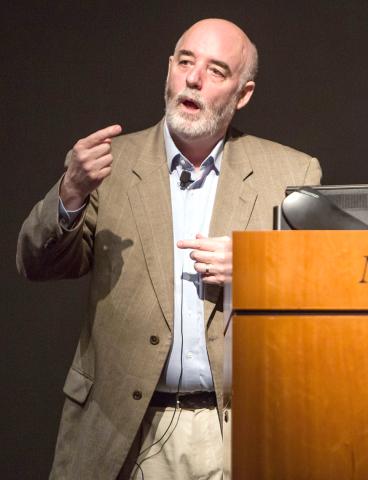Cancer-Causing Viruses Yield Clues to New Treatments

Photo: Chia-Chi Charlie Chang
There are at least 7 viruses that are known to cause cancer. Of those, Dr. Patrick Moore and his colleague and wife Dr. Yuan Chang discovered and characterized two. These insights are the first steps toward developing new cancer vaccines and treatments, Moore recounted at the George Khoury Lecture in Masur Auditorium recently.
“Viruses and other infectious agents are responsible for 1 out of 5 cancers world-wide,” said Moore, American Cancer Society professor at the University of Pittsburgh Cancer Institute. That number might be on the low side, he cautioned, since many developing countries are not likely to detect patients who have cancer caused by viruses.
In 1994, Moore and Chang discovered Kaposi’s sarcoma associated herpesvirus (KSHV), the viral cause of Kaposi’s sarcoma. Then, in 2008, they found Merkel cell polyomavirus (MCV), the viral cause of most Merkel cell carcinomas.
During the HIV/AIDS pandemic in the 1980s, the incidence of Kaposi’s sarcoma spiked. This is a cancer that can form in the skin, mucous membranes lining the mouth or nose, lymph nodes and other organs. At the time, “it was a remarkable incident in medicine,” said Moore, because cancers didn’t occur as epidemics. That school of thought changed when Moore and Chang discovered KSHV, the DNA virus responsible for Kaposi’s sarcoma. It became well-known that immunosuppressed patients developed sarcomas at higher rates.
“What’s different from other human tumor viruses is that KSHV in its evolution has stolen genes from the host genome,” Moore explained. “One thing that became quite clear is that many of these genes actually target the immune system.”
A healthy cell has a few options to ward off infection. It can, for example, stop dividing to prevent a virus from infecting other cells. The cell can also kill itself—a normal process called apoptosis. When KSHV infects a cell, he said, the virus disables the cell’s innate immune response and ability to kill itself.
Under certain circumstances, such as when a person’s immune system is weakened by HIV infection, KSHV can lead to the development of Kaposi’s sarcoma. Moore suspects the virus replicates only when certain functions in the immune system are weakened. When that happens, tumors can grow, as well. That suggests there’s an interplay between how the immune system controls infection and the prevention of tumor growth.
“If we have a tumor, which has a series of mutations and various tumor suppressor genes that happen to knock out innate immunity, then those tumor cells should be more susceptible to viral infection,” he posited. This is the basis for viral oncolytic therapies that have been FDA-approved for treatment of melanoma, a serious form of skin cancer.

Photo: Chia-Chi Charlie Chang
Moore then discussed MCV. A rare and aggressive form of skin cancer, Merkel cell carcinoma commonly occurs in patients with HIV and in elderly adults. Moore said identifying the virus was the result of a 7-year effort to develop a method that sequenced RNA found in tumors. The virus has two genes and it’s found in about 80 percent of all Merkel cell carcinomas.
MCV infections occur during childhood and are lifelong. The exact mechanism for how it persists is still not well characterized, but there are possible explanations. The virus integrates into human DNA. It cannot replicate on its own. Under most circumstances, Moore explained, MCV uses a mechanism called “protein-mediated viral latency.” This means the virus’s ability to replicate “has evolved to be constrained in expression.” In other words, the virus stays dormant until it becomes advantageous to replicate itself. That might be because cells mutate, for example.
“I don’t want to imply that this is the only mechanism that these small viruses use to maintain latency, but I think that it’s likely to be an important one,” he said.
There are many reasons why studying tumor virology is important, he noted. By learning, for instance, how viruses function, scientists can learn about interactions between the immune system and how tumors form.
These discoveries could be first steps toward developing vaccines for viruses responsible for causing 1 in 5 cases of cancer, which could “change the course of human cancer,” Moore concluded.
